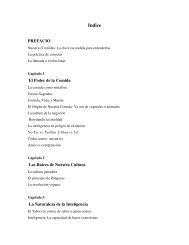The World Peace Diet: Eating For Spiritual Health And Social Harmony
The World Peace Diet: Eating For Spiritual Health And Social Harmony
The World Peace Diet: Eating For Spiritual Health And Social Harmony
Create successful ePaper yourself
Turn your PDF publications into a flip-book with our unique Google optimized e-Paper software.
302 / the world peace diet<br />
Little, Brown, 1975), p. 180, cited in Davis, Prisoned Chickens, Poisoned Eggs,<br />
p. 39.<br />
33. C. David Coats, Old McDonald’s Factory Farm: <strong>The</strong> Myth of the Traditional Farm<br />
and the Shocking Truth about Animal Suffering in Today’s Agribusiness (New York:<br />
Continuum, 1989), pp. 93–94, cited in Davis, Prisoned Chickens, Poisoned Eggs,<br />
pp. 39–40.<br />
34. <strong>For</strong> more information on “free-range” practices, see www.upc-online.org/freerange.html.<br />
Chapter 8—<strong>The</strong> Metaphysics of Food<br />
1. Ken Wilber, A Brief History of Everything (Boston: Shambhala, 1966), p. 4.<br />
2. D. Olwens, et al. “Circulating Testosterone Levels and Aggression in Adolescent<br />
Males: A Causal Analysis,” Psychosomatic Medicine, 50, 1988, pp. 261–272.<br />
3. Neal Barnard, Eat Right, Live Longer (New York: Crown Books, 1993).<br />
4. Ibid.<br />
5. Jianghong Liu, et al., “Early Nutrition and Antisocial Behavior,” American Journal<br />
of Psychiatry, November 2004. See www.newstarget.com/006194.html, also<br />
www.usc.edu/uscnews/stories/10773.html.<br />
6. <strong>The</strong> Heisenberg uncertainty principle is based on the realization in the 1920s that<br />
light manifests as a nonlocal continuous wave or as discrete particles depending<br />
on the choice and will of the observer. <strong>The</strong>re is inherent uncertainty in observation<br />
of small particles because it is impossible to discern simultaneously and with<br />
high accuracy both the position and the momentum of a particle such as an electron<br />
or photon. <strong>The</strong> very act of observing and measuring inherently changes the<br />
nature of the particle wave. <strong>The</strong> observer effect is based on the realization by<br />
researchers (not just in the “hard” sciences such as physics, but also in anthropology<br />
and other social sciences) that the act of observation necessarily influences<br />
whatever is being observed. <strong>The</strong> apparent subject/object split is increasingly seen<br />
to be illusory. <strong>For</strong> more information on these ideas, see Fritjof Capra, <strong>The</strong> Tao of<br />
Physics and <strong>The</strong> Turning Point; Gary Zukav, <strong>The</strong> Dancing Wu Li Masters; Ishtak<br />
Bentov, Stalking the Wild Pendulum; Fred Alan Wolf, Mind Into Matter; Amit<br />
Goswami, <strong>The</strong> Self-Aware Universe: How Consciousness Creates the Material<br />
<strong>World</strong>; and others.<br />
7. Cited in Gregg Braden, “Living in the Mind of God,” Horizons Magazine, February<br />
2003, p. 9.<br />
8. <strong>And</strong>rew Weil, <strong>Health</strong> and Healing (New York: Houghton Mifflin, 1998), pp.<br />
199–254.<br />
9. See J. Alan Boone, Kinship With All Life (New York: HarperCollins, 1954), as well<br />
as previously cited books by Rupert Sheldrake.<br />
10. Thich Nhat Hanh, <strong>Peace</strong> Is Every Step (New York: Bantam, 1991), p. 24.<br />
11. Thich Nhat Hanh, Anger (New York: Penguin Putnam, 2001), pp. 15–16.<br />
12. Charles Fillmore, “As to Meat <strong>Eating</strong>,” Unity Magazine, October 1903.<br />
13. Charles Fillmore, “Flesh-<strong>Eating</strong> Metaphysically Considered,” Unity Magazine, May<br />
1910.<br />
14. Wendy Melillo, “Doctor’s Group Blasts Milk Ads,” Adweek, May 7, 2001, p. 8.<br />
15. “Reverence,” Albert Schweitzer Fellowship Quarterly, Fall 1997, p. 27.<br />
16. Shabkar, Food of Bodhisattvas, translated by the Padmakara Translation Group<br />
(Boston: Shambhala, 2004), p. 60.<br />
17. Lobsang Lhalungpa, tr., <strong>The</strong> Life of Milarepa (New York: Penguin, 1977), p. 154.<br />
18. Cited in <strong>And</strong>rew Linzey, Animal <strong>The</strong>ology (Urbana and Chicago: University of<br />
Illinois Press, 1995), p. 56.<br />
19. J. R. Hyland, God’s Covenant with Animals: A Biblical Basis for the Humane<br />
Treatment of All Creatures (New York: Lantern, 2000), p. xii.



